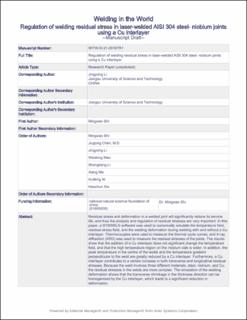| dc.contributor.author | Shi, Mingxiao | |
| dc.contributor.author | Chen, Jiugong | |
| dc.contributor.author | Li, Jingyong | |
| dc.contributor.author | Mao, Weidong | |
| dc.contributor.author | Li, Shengliang | |
| dc.contributor.author | Ma, Xiang | |
| dc.contributor.author | Ni, Huifeng | |
| dc.contributor.author | Xia, Haochun | |
| dc.date.accessioned | 2022-06-17T11:33:54Z | |
| dc.date.available | 2022-06-17T11:33:54Z | |
| dc.date.created | 2021-10-13T12:33:36Z | |
| dc.date.issued | 2021 | |
| dc.identifier.citation | Welding in the World. 2021, 65 (12), 2283-2294. | en_US |
| dc.identifier.issn | 0043-2288 | |
| dc.identifier.uri | https://hdl.handle.net/11250/2999308 | |
| dc.description.abstract | Residual stress and deformation in a welded joint will significantly reduce its service life, and thus the analysis and regulation of residual stresses are very important. In this paper, a SYSWELD software was used to numerically simulate the temperature field, residual stress field, and the welding deformation during welding with and without a Cu interlayer. Thermocouples were used to measure the thermal cycle curves, and X-ray diffraction (XRD) was used to measure the residual stresses of the joints. The results show that the addition of a Cu interlayer does not significantly change the temperature field, and that the high temperature region on the niobium side is wider. In addition, the peak temperature in the centre of the welds and the temperature gradient perpendicular to the weld are greatly reduced by a Cu interlayer. Furthermore, a Cu interlayer contributes to a certain increase in both transverse and longitudinal residual stresses. Because the weld involves three different materials, steel, niobium, and Cu, the residual stresses in the welds are more complex. The simulation of the welding deformation shows that the transverse shrinkage in the thickness direction can be homogenized by the Cu interlayer, which leads to a significant reduction in deformation. | en_US |
| dc.language.iso | eng | en_US |
| dc.publisher | Springer Nature | en_US |
| dc.title | Regulation of welding residual stress in laser-welded AISI 304 steel-niobium joints using a Cu interlayer | en_US |
| dc.type | Peer reviewed | en_US |
| dc.type | Journal article | en_US |
| dc.description.version | acceptedVersion | en_US |
| dc.rights.holder | This version of the article has been accepted for publication, after peer review and is subject to Springer Nature’s AM terms of use, but is not the Version of Record and does not reflect post-acceptance improvements, or any corrections. The Version of Record is available online at: https://doi.org/10.1007/s40194-021-01177-1 | en_US |
| dc.source.pagenumber | 2283-2294 | en_US |
| dc.source.volume | 65 | en_US |
| dc.source.journal | Welding in the World | en_US |
| dc.source.issue | 12 | en_US |
| dc.identifier.doi | 10.1007/s40194-021-01177-1 | |
| dc.identifier.cristin | 1945561 | |
| cristin.ispublished | true | |
| cristin.fulltext | postprint | |
| cristin.qualitycode | 1 | |
